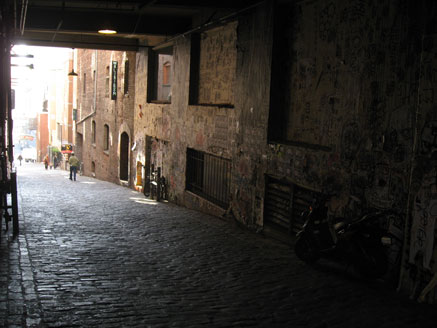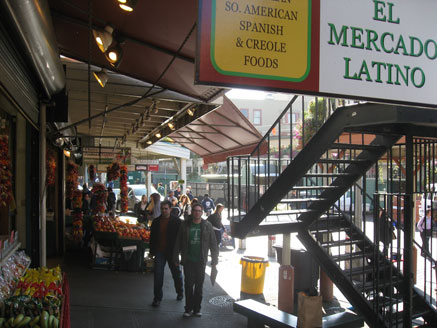[Note: I didn’t have my camera with me at the time, so I have no photos of Will. The photos may thus seem confusing or irrelevant (sorry). I took these market shots the next day.]
Lately I’ve been wandering up to Pike Place Market every day during lunch, or if I spend my lunch hour at my desk, then later on in the afternoon, just to get out, knock elbows with humanity, breathe the light.
For those of you who aren’t familiar with it, the market is a tourist attraction all year long and especially in the summer, representing some kind of dream people have — people a lot like me, actually — of what Seattle used to be, though it is largely a fiction.
There’s man named Will who sells prints of his paintings, and some originals, at roughly the same spot most days. They are oils, or maybe acrylics, and the majority of them are scenes of the American West, though he seems to be frequently captivated also by small, colorful birds. The western scenes are often set in Montana, where a friend of his runs a dude ranch that he goes and helps out on periodically. Will, whose initials WJC appear at the bottom of his paintings, is not a real (i.e. “full time”) cowboy, even though he looks like one. His face, arranged around a graying moustache and topped by a humble and weathered cowboy hat, is very friendly, and he’s very easy to talk to.
I first stopped at his booth when I caught sight of a painting called “Buster’s Horses”. It is a painting of four or five brown horses standing in a group with the Montana sky above and all around them. The particular angle that the horses stood in relation to each other, and the way they nudged at each other and the way their ears were positioned, all reminded me of horses I once tended and looked very real to me. It smacked of a photograph, and I paused to ask the artist if he painted from photos, which he said he did. I was relieved, because I didn’t see how it was possible to capture such a convincingly equine moment live. That’s how I met Will. He said many people respond to that painting and the he sells more of that print than of any other.
I saw him again today and said hello. He remembered my face from before and remembered that I had also been around horses at one time. I asked him today about the technique he used to create the effect of very minute brickwork in the background behind one of his birds. He told me that after painting the bird and photographing the painting, he used a repeating digital brick pattern in GIMP (a program like Photoshop for image manipulation) to create the effect of a brick wall behind the bird in the final print. Again, I was relieved, because again, it didn’t seem likely that the human hand could render so many perfectly straight lines. I used to paint in oils, and I had a pretty steady hand, but I have always wondered — ever since gazing at the album art of the 1970s — how artists who did other kinds of painting than what I did, which was straight-up hand application with brushes, could create such fine and intricate illusions of pattern. I don’t wonder about it anymore when I’m looking at an image online — I assume the miracle of Photoshop — but when a print in front of me depicts a canvas that clearly has paint on it and yet also has this amazing “other” stuff, well, I knew if I walked away without asking about it it would gnaw at me.

Real people. Real work. Real coffee. Piano busker Johhny Hahn (in red jacket at bottom of sidewalk) and his upright-on-wheels is a well-known Pike Place fixture.
Will was happy to describe the whole process for me. He has not been a painter for many years, if I recall correctly my previous conversation with him, and in any case he doesn’t seem to regard his art as deeply mysterious, though I should hate to put many more words in his mouth than that. He has (or had) a city job, and he goes to Montana at whiles to connect with the outdoors and the work of wrangling and other men who appreciate those things. And he paints images from photographs that he takes there and elsewhere. I don’t imagine he’s getting rich as an artist. Twelve bucks for a small print (about 8×10), or two for twenty bucks. Larger ones are more, but reasonable for original art, colorful and striking.
I like one I saw today that is just a stirrup with a cowboy-booted foot in it against the warm flank of a horse, and another of the back of a horse (no head showing) with what he called a Miles City saddle on it and a hillside and barn in the distance. (Many of his works show views that are not traditionally centered on their subjects. It’s almost as if you are getting a momentary look through the eyes of some cowboy in whatever direction he happens to be facing, and whatever happens to fill that view, at whatever angle or relationship to the horizon, that’s what you get.)
I asked what a Miles City saddle was. “Is that a place?”
Will said it was a place in eastern Montana, the saddle-making center of the world at one time. “The saddlery there outfitted Prussian cavalry,” he said. “But then came the automobile and that was the end of that.” Surreally, as he spoke these words, a mounted Seattle Police officer clopped down the cobblestoned avenue directly behind him. “My friend found that saddle at a garage sale and bought it for 700 bucks. It turned out to be an antique. But he still uses it. I always use it when I go back there.”

Ol' Number 78, historical example of a gen-yoo-wine Miles City Saddlery saddle. Image purloined from Miles City Saddlery website.
I love how unexpected bits of history or culture and arcana take me by complete surprise in conversations like this. Now I know a little about the process of creating prints. And who knew about Miles City? I also learned from Will that his agreement with the market requires him to display and sell a certain percentage of original works, as opposed to prints. Apparently, he says, they think that print artists are just people who splash a little paint on a canvas and then photocopy it a million times and artlessly make piles of money. He said other artists in the market dismiss the work that goes into making the artwork he sells, but complain about the difficulty of producing their own. Will has several mid-size originals for sale to satisfy the market, or his fellow vendors, or whoever it is that has the gall to pester an honest cowboy artist about authenticity.
As I prepared to motor on, we said our names again and promised to remember this time. He said if he used my name once he’d probably remember.
“Alright Will, we’ll be seein’ ya.”
“Okay, Matt. You take care.”

